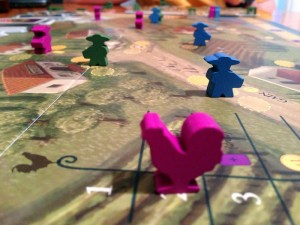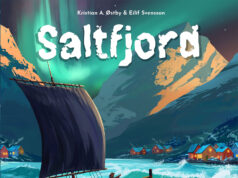 Last fall I took a trip out to Tuscany and visited an Italian vineyard. It was quite the experience and probably the highlight of our trip to Italy. We got to see a lot of the process of what goes into making wine, including getting a lot of free samples!
Last fall I took a trip out to Tuscany and visited an Italian vineyard. It was quite the experience and probably the highlight of our trip to Italy. We got to see a lot of the process of what goes into making wine, including getting a lot of free samples!
So I was pretty excited recently to get a copy of Viticulture from Stonemaier Games. Viticulture bills itself as “the strategic game of winemaking.” Players must shrewdly run their vineyard to try and outproduce their opponents. Is this new worker placement game worth your time in this crowded genre? Read on to find out.
Viticulture is a worker placement and resource management game for 3-6 players that plays in about 60 minutes. We’ve found Viticulture plays best with 3 or 5 players.
Game Overview:
Each player is in charge of running a pre-modern Tuscan vineyard. The game is played over a series of years (rounds), each of which has 4 seasons. Each turn a player will send their workers out to improve their vineyard; plant, harvest and crush grapes; and make and sell wine. Players will also play action cards along the way to give themselves special actions or a little boost.

In Viticulture, there is no time limit or a set number of rounds. Instead you have a steady march to the finish line by all players. The players must wisely manage their resources of money, workers, grapes and wine in order to be the first player to score 20 victory points.
Components:
One thing I love about Viticulture is that it looks fantastic. Included is a large main game board and six player boards. These boards are well illustrated to fit the Tuscan theme and are double-sided with one side including worker placement instructions to aid the players.
Also included are a number of custom, wooden tokens to represent your workers and various farm improvements. I absolutely love these tokens as they are all representative of things you are building on the farm and feel quite unique. Stonemaier Games could have easily used cubes or cardboard tokens for these so it’s nice to see the extra touch with the wooden tokens. Players also get 4 decks of cards (grapes vines, wine orders, summer and winter visitors), money tokens and glass wine/grape tokens.
Finally, I have to admit I have a love/hate affair with the rulebook. I love how it looks. It is beautifully illustrated and feels right at home with the theme of the game. As a graphic designer myself, I can fully appreciate when a printed book looks this good. However, I feel the rulebook could have been laid out a little better. The end game rules are on the first page (not at the end of the round explanation like you might expect), the setup rules are in two parts and other important rules that should have been highlighted are buried in a paragraph (like not being able to combine grapes when making wine). It’s not a bad rulebook by any stretch, I just wish it were a little better. It does do some things really well, like explaining summer and winter action spaces. Fortunately, as Viticulture is not a heavy game, it’s not really a huge issue, especially with the game board having action space descriptions to aid the players.
How to Play:

Each player starts the game with a player mat, 3 workers, a Pinot vine card, 3 money and a random summer visitor card. The game will be played out in a series of “years” with each year equaling one round of the game. The years always start with the Spring action.
The Round Order:
1) Spring – This is where players decide when they will be “waking up” for the year. The first player chooses his time slot first and other players then choose in a clockwise rotation. This brilliant mechanic lets players choose their turn order for the coming round. Wherever they place their worker on the chart, that will decide when they go. The nice part is that each space has a bonus (except the first). The later a player wakes up, the better the bonus.
2) Summer – In this season players will place their workers on any of the Summer action spaces. The Summer actions include: Constructing buildings, planting vines, drawing vine cards, playing summer visitor cards, selling grapes, and giving tours. These are mostly actions that improve your vineyard or prepare for winter actions. Players only get 1 allocation of workers per year so it’s important to save some for the winter season!
3) Fall – Each player draws a visitor card, either a Summer or Winter card. Summer cards help you build up your vineyard while Winter helps you reap what you’ve sown.
4) Winter – Much like summer, players may place workers on the Winter action spaces. As stated earlier, you only get to use the workers you have left over from Summer. Possible actions are: Draw a wine order card, play a winter visitor card, hire another worker, harvest a field, crush grapes into wine and fill a wine order.
After that, the round ends with a few cleanup actions. Players age (increase in value) their wine and grape tokens, collect their workers back, possibly collect some income and rotate the first player token. I should note to help avoid confusion, the first player token is only used to decide who picks first during the Spring for wake-up selection.
That’s the basic round structure. The game flows really well and most worker spaces are self-explanatory. A players ultimate goal is to make and sell wine, which is done with the crush grapes action. That involves moving your grape tokens from your crush pads to the wine cellar. Some grapes can be combined to make “blush” wine or “sparkling” wines. The years will continue in this fashion until a player hits 20 victory points. At that point the round is finished and the player with the most victory points is the winner.

Game Experience:
Let me start by saying that I have played a bunch of games of Viticulture and it is quickly becoming one of my favorite worker placement games. First off, I think the theme was a risky but great choice. At first I wasn’t sure I’d be that interested in a game about winemaking, but the designer did a great job of tying the theme to the game. From the game’s beautifully illustrated Tuscan landscape on the boards to the multiple wooden vineyard tokens, Viticulture does a great job of tossing you into the rolling hills of Tuscany. I feel like I see a new fantasy or zombie themed game everyday, so it’s really refreshing to see someone heading in a new direction when designing a game.
One of the best things about Viticulture is that every game will play differently. Sometimes in other games there is a clear path to victory and everyone races toward it. Not so with Viticulture. There are many, many different ways you can go about winning and in our games, that usually seems to happen. Sometimes the direct route isn’t always the best way to go. There are many ways to earn victory points in Viticulture, not just by the obvious route of selling wine. In fact, in one of our games, I was having a really hard time filling my wine orders, so I switched gears and built a tasting room (earn a VP when you give a tour). By doing that, I was able to keep my score close to my opponents while I worked on trying to ship out some wine.

That’s also one of the great things about Viticulture, the game’s balance. In just about every game we played, each player was in it until the very end. Much like drinking a fine wine, victory points in Viticulture will be earned slowly over the course of the game. Occasionally a player might get 3-4 of them with a well timed action card or an expensive wine order, but those will be the rarity. For the most part, players should be close to each other in scoring throughout the game.
As I mentioned earlier, I also love the wake-up mechanic. It was a brilliant idea that replaces the standard clockwise rotation for the first player. Each player gets to decide when they want to wake up with the later times giving a better bonus (They start out small with a card draw and eventually get up to a VP or a temporary worker). Sometimes I’d agonize over what time to choose as I had to balance getting first choice at the placement spots with one of the better bonuses. Easily my favorite mechanic in the game.
The game also flows really well from one turn to the next. Since the action spaces are broken up over 2 seasons, it helps to cut down on a player’s analysis paralysis as they only have to decide from half the actions at a time. This was a clever mechanic which I was able to appreciate from the start. It takes some pre-planning and tough decision making since your yearly allotment of workers has to be split up between the Summer and Winter seasons. I’m constantly running calculations in my head over which worker I want to go where and hoping my opponents don’t screw up my well laid plans.
Viticulture does a lot of things right in the crowded worker placement genre. However, we did have a few minor gripes with the game. First, the game’s scaling isn’t the best. The game easily plays best with 3 players and 5 being a close second. When playing with 2 players, you only get one worker spot for each action space so it’s very easy to get blocked. With 3 players, a second action spot opens up (including the one that includes a bonus), and it is much, much easier to get what you need. We just felt the game played and flowed better with these extended options. In a 2 and 4 player game the limited action spots might lead to some player frustration if someone gets repeatedly gets locked out of actions. Despite all that, Viticulture is still a fun game with 2 or 4 players, we just have to go in knowing it will be a lot tighter of a game.

The other thing I want to mention are the visitor cards. Some can be incredibly powerful if played at the right time. We have seen some pretty big swings in the game by a player playing the right card at the right time. It’s funny to watch other players look green with envy when you play a particularly good card at the right time. Especially if their card is a dud in comparison. If this kind of randomness in a game bothers you, then it’s something to be aware of because some cards are just better than others.
That being said, I do love the visitor cards. There is a great amount of difference between them and I like that kind of variation in my games. Playing the right card at the right time is very satisfying and adds a good amount of strategy to the game. Every player we have played the game with loves hoarding these visitor cards. Some of the cards will also duplicate worker spaces (but with a bonus) so they are great for times when you’ve been blocked out of a crucial spot.
Lastly, Viticulture also features some great resource management. In the beginning of the game, money and workers are extremely tight. This calls for some tough decisions on what to do with your turns. As the game progresses, these become much less of an issue and managing your wine and grapes becomes the center focus of the game. As players inch nearer and nearer to that 20 point win spot, every action becomes of crucial importance. I do like this element of resource management in the game, only I wish money had a bit more importance later in the game. Eventually it will pile up only to be used as a tie breaker, which rarely happens.
Final Thoughts:

Despite my relatively minor gripes with Viticulture, it stands as one of my favorite worker placement games. While it might not be the perfect game, it is a whole lot of fun. I’ve found the more familiar I get with the game, the more I enjoy it. Since there are so many different paths to victory, I have been enjoying trying out new strategies each game.
Viticulture is going to be keeping a permanent spot in my collection partially because it plays so well with 3 players. There will still be competition for spots, but you won’t feel hampered by being blocked as often. It’s sometimes really hard to find a game that balances well with three players and Viticulture nails that one with spades.
I haven’t decided yet how accessible the game is though. I don’t think you have to be a gamer to enjoy it, but I also think it may be slightly too complex for your non-gamer friends. I think Viticulture might fall into the collection of games to play after your friends have moved on from “gateway games”. It’s a medium weight euro game, but probably on the lighter side of the that scale.
When all is said and done, Viticulture provides a great theme, some beautiful components, and really smooth game play. I’d highly recommend picking up a copy if you can get your hands on one. Just don’t forget to open a bottle of wine while you play.
If you are interested in getting a copy for yourself, it’s about $50
Final Score: 4 Stars – A great medium weight worker placement game with some unique mechanics and a new theme.
 Hits:
Hits:
• Great wake up mechanic for choosing turn order
• A new theme that’s tied well to the game
• Lots of customized tokens
• Wonderful, thematic artwork
• Quick play time and easy to learn rules
Misses:
• Visitor cards can be really powerful at the right times
• Rulebook could have been laid out better.






















Thank you so much for this review! I appreciate your praise, and I respect the faults you find with the game. I’m glad the game stands on its own, and I look forward to improving it with future expansions.
I’ve got this one on order at coolstuffinc.com with some pre-orders, looking forward to getting it!
Great review for a great game. I really enjoy how you summarize pros/cons at the end, makes it easy for people to skim and see the summary.
Are you planning to review the second edition and Tuscany?
We will not be doing a second edition review, since it’s mostly unchanged other than a few rule tweaks. However, we will be doing a Tuscany review. We are about halfway through playing all the modules, so it will be a little bit more time. It was quite the expansion!